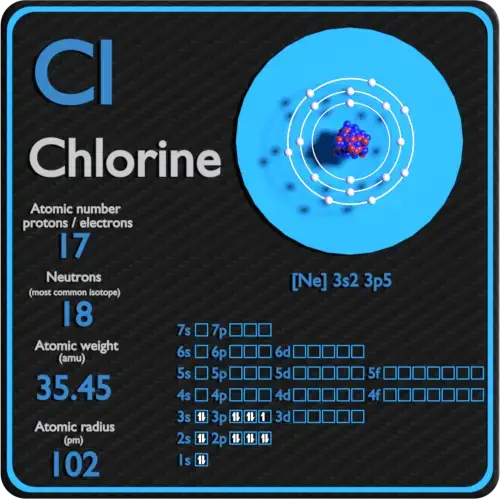
Chlorine is a yellow-green gas at room temperature. It is an extremely reactive chemical element and a strong oxidising agent: among the elements, it has the highest electron analogousness and the 3rd-highest electronegativity, behind only oxygen and fluorine.
While perchance all-time known for its function in providing make clean drinking water, chlorine chemical science too helps provide energy-efficient edifice materials, electronics, fiber optics, solar free energy cells, 93 percent of life-saving pharmaceuticals, 86 pct of crop protection compounds, medical plastics, and much more.
Elemental chlorine is commercially produced from brine by electrolysis, predominantly in the chlor-alkali process.
Protons and Neutrons in Chlorine
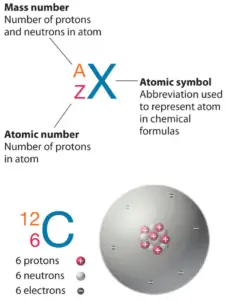 Chlorine is a element with diminutive number17 which ways there are 17 protons in its nucleus. Total number of protons in the nucleus is called theatomic number of the atom and is given thesymbol Z. The total electrical charge of the nucleus is therefore +Ze, where eastward (unproblematic charge) equals toi,602 ten 10-nineteen coulombs.
Chlorine is a element with diminutive number17 which ways there are 17 protons in its nucleus. Total number of protons in the nucleus is called theatomic number of the atom and is given thesymbol Z. The total electrical charge of the nucleus is therefore +Ze, where eastward (unproblematic charge) equals toi,602 ten 10-nineteen coulombs.
The total number of neutrons in the nucleus of an atom is called theneutron number of the cantlet and is given thesymbol N. Neutron number plus atomic number equals diminutive mass number:N+Z=A. The divergence between the neutron number and the atomic number is known every bit theneutron backlog: D = N – Z = A – 2Z.
For stable elements, there is ordinarily a variety of stable isotopes. Isotopes are nuclides that accept the same atomic number and are therefore the aforementioned element, but differ in the number of neutrons. Mass numbers of typical isotopes of Chlorine are35; 37.
Chief Isotopes of Chlorine
Chlorine has two stable isotopes, 35Cl and 37Cl. These are its only two natural isotopes occurring in quantity, with 35Cl making up 76% of natural chlorine and 37Cl making upwardly the remaining 24%.The longest-lived radioactive isotope is 36Cl, which has a half-life of 301,000 years. All other isotopes have half-lives under 1 hour, many less than one second.
Chlorine-35 is equanimous of 17 protons, 18 neutrons, and 17 electrons.
Chlorine-37 is equanimous of 17 protons, 20 neutrons, and 17 electrons.
Chlorine-36 is equanimous of 17 protons, nineteen neutrons, and 17 electrons. Trace amounts of radioactive36Cl be in the environment, in a ratio of nigh 7×10−13 to 1 with stable isotopes.36Cl is produced in the atmosphere by spallation of36Ar past interactions with cosmic ray protons.
Electrons and Electron Configuration
The number of electrons in an electrically-neutral atom is the same every bit the number of protons in the nucleus. Therefore, the number of electrons in neutral atom of Chlorine is 17. Each electron is influenced by the electrical fields produced past the positive nuclear charge and the other (Z – 1) negative electrons in the atom.
Since the number of electrons and their organization are responsible for the chemical behavior of atoms, theatomic number identifies the various chemical elements. The configuration of these electrons follows from the principles of quantum mechanics. The number of electrons in each element's electron shells, especially the outermost valence crush, is the primary gene in determining its chemic bonding behavior. In the periodic table, the elements are listed in order of increasing atomic number Z.
Electron configuration ofChlorineis[Ne] 3s2 3p5.
Possible oxidation states are+1,5,7/-one.
It is an extremely reactive element and a potent oxidising agent: amid the elements, it has the highest electron affinity and the tertiary-highest electronegativity on the Pauling scale, backside just oxygen and fluorine. Because of its great reactivity, all chlorine in the World'due south crust is in the class of ionic chloride compounds, which includes common salt. It is the 2d-about abundant halogen (after fluorine) and twenty-beginning well-nigh arable element in Earth's crust.
Mutual Compound of Chlorine
The simplest chlorine compound is hydrogen chloride, HCl, a major chemical in industry as well as in the laboratory, both every bit a gas and dissolved in water as hydrochloric acid. It is often produced by burning hydrogen gas in chlorine gas, or as a byproduct of chlorinating hydrocarbons. Hydrogen chloride gas and muriatic acid are important in engineering science and manufacture.
About Protons
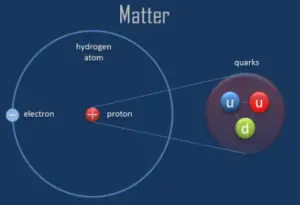 A proton is one of the subatomic particles that make up matter. In the universe, protons are abundant, making upwardlyabout half of all visible thing. It hasa positive electric charge (+1e) and a remainder mass equal to 1.67262 × 10−27 kg (938.272 MeV/c two )— marginally lighter than that of the neutron merely nearly 1836 times greater than that of the electron. The proton has a hateful square radius of about 0.87 × x−xv yard, or 0.87 fm, and it is a spin – ½ fermion.
A proton is one of the subatomic particles that make up matter. In the universe, protons are abundant, making upwardlyabout half of all visible thing. It hasa positive electric charge (+1e) and a remainder mass equal to 1.67262 × 10−27 kg (938.272 MeV/c two )— marginally lighter than that of the neutron merely nearly 1836 times greater than that of the electron. The proton has a hateful square radius of about 0.87 × x−xv yard, or 0.87 fm, and it is a spin – ½ fermion.
The protons exist in the nuclei of typical atoms, forth with their neutral counterparts, the neutrons. Neutrons and protons, commonly callednucleons, are bound together in the atomic nucleus, where they business relationship for 99.nine percentage of the atom'southward mass. Research in high-free energy particle physics in the 20th century revealed that neither the neutron nor the protonis not the smallest edifice block of affair.
About Neutrons
A neutron is one of the subatomic particles that make up thing. In the universe, neutrons are arable, making upwardsmore than than half of all visible affair. Information technology hasno electric accuse and a rest mass equal to 1.67493 × 10−27 kg—marginally greater than that of the proton merely nearly 1839 times greater than that of the electron. The neutron has a mean square radius of about 0.8×ten−xv 1000, or 0.8 fm, and it is a spin-½ fermion.
Atomic nuclei consist of protons and neutrons, which attract each other throughthe nuclear force, while protons repel each other viathe electrical strength due to their positive charge. These ii forces compete, leading to various stability of nuclei. In that location are merely certain combinations of neutrons and protons, which formsstable nuclei.
Neutrons stabilize the nucleus, because they attract each other and protons , which helps commencement the electric repulsion between protons. As a result, as the number of protons increases,an increasing ratio of neutrons to protons is needed to form a stable nucleus. If there are too many or likewise few neutrons for a given number of protons, the resulting nucleus is non stable and it undergoes radioactive disuse.Unstable isotopesdecay through diverse radioactive decay pathways, most commonly alpha decay, beta decay, or electron capture. Many other rare types of decay, such as spontaneous fission or neutron emission are known. It should be noted that all of these decay pathways may be accompanied pastthe subsequent emission of gamma radiation. Pure blastoff or beta decays are very rare.
About Electrons and Electron Configuration
The periodic table is a tabular display of the chemic elements organized on the basis of their atomic numbers, electron configurations, and chemic properties. The electron configuration is the distribution of electrons of an atom or molecule (or other physical structure) in atomic or molecular orbitals. Knowledge of theelectron configuration of dissimilar atoms is useful in understanding the construction of the periodic table of elements.
Every solid, liquid, gas, and plasma is composed of neutral or ionized atoms. Thechemical properties of the atom are determined past the number of protons, in fact, past number andarrangement of electrons. Theconfiguration of these electrons follows from the principles of breakthrough mechanics. The number of electrons in each element'south electron shells, peculiarly the outermost valence vanquish, is the chief factor in determining its chemical bonding behavior. In the periodic table, the elements are listed in lodge of increasing atomic number Z.
Information technology is thePauli exclusion principle that requires the electrons in an atom to occupy different energy levels instead of them all condensing in the ground state. The ordering of the electrons in the footing land of multielectron atoms, starts with the lowest energy state (ground state) and moves progressively from there up the free energy scale until each of the atom'southward electrons has been assigned a unique set of breakthrough numbers. This fact has key implications for the edifice upward of the periodic tabular array of elements.
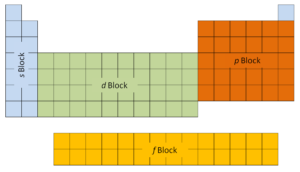 The first ii columns on the left side of the periodic table are where thedue south subshells are being occupied. Because of this, the first two rows of the periodic tabular array are labeled thesouth cake. Similarly, thep blockare the right-most half-dozen columns of the periodic tabular array, thed cakeis the middle 10 columns of the periodic tabular array, while thef cakeis the 14-column section that is normally depicted as detached from the master body of the periodic table. It could exist part of the chief torso, merely then the periodic tabular array would be rather long and cumbersome.
The first ii columns on the left side of the periodic table are where thedue south subshells are being occupied. Because of this, the first two rows of the periodic tabular array are labeled thesouth cake. Similarly, thep blockare the right-most half-dozen columns of the periodic tabular array, thed cakeis the middle 10 columns of the periodic tabular array, while thef cakeis the 14-column section that is normally depicted as detached from the master body of the periodic table. It could exist part of the chief torso, merely then the periodic tabular array would be rather long and cumbersome.
For atoms with many electrons, this notation can become lengthy and and then an abbreviated notation is used. The electron configuration can exist visualized as the core electrons, equivalent to theelement of group 0 of the preceding period, and the valence electrons (e.g. [Xe] 6s2 for barium).
Oxidation States
Oxidation states are typically represented by integers which may be positive, zero, or negative. Near elements have more than one possible oxidation state. For case, carbon has nine possible integer oxidation states from −4 to +4.
The current IUPAC Gold Book definition of oxidation state is:
"Oxidation state of an atom is the accuse of this cantlet afterward ionic approximation of its heteronuclear bonds…"
and the term oxidation number is nearly synonymous. An element that is not combined with any other different elements has an oxidation state of 0. Oxidation state 0 occurs for all elements – it is just the element in its elemental course. An atom of an element in a compound will have a positive oxidation land if it has had electrons removed. Similarly, adding electrons results in a negative oxidation state. We accept also distinguish between the possible and common oxidation states of every element. For case, silicon has ix possible integer oxidation states from −4 to +iv, but only -4, 0 and +iv are common oxidation states.
Summary
| Element | Chlorine |
| Number of protons | 17 |
| Number of neutrons (typical isotopes) | 35; 37 |
| Number of electrons | 17 |
| Electron configuration | [Ne] 3s2 3p5 |
| Oxidation states | +i,5,7/-1 |
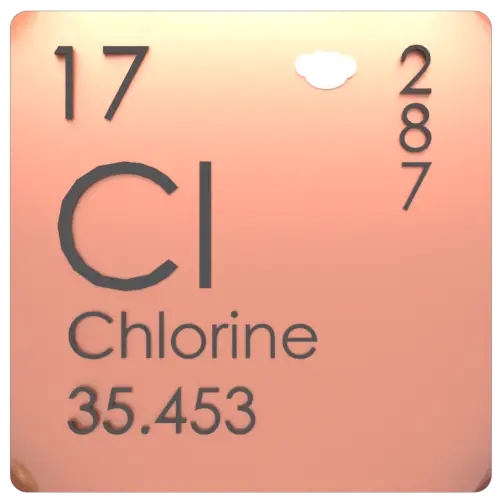
Source: world wide web.luciteria.com
Other properties of Chlorine

 Chlorine is a element with diminutive number17 which ways there are 17 protons in its nucleus. Total number of protons in the nucleus is called theatomic number of the atom and is given thesymbol Z. The total electrical charge of the nucleus is therefore +Ze, where eastward (unproblematic charge) equals toi,602 ten 10-nineteen coulombs.
Chlorine is a element with diminutive number17 which ways there are 17 protons in its nucleus. Total number of protons in the nucleus is called theatomic number of the atom and is given thesymbol Z. The total electrical charge of the nucleus is therefore +Ze, where eastward (unproblematic charge) equals toi,602 ten 10-nineteen coulombs.

 A proton is one of the subatomic particles that make up matter. In the universe, protons are abundant, making upwardlyabout half of all visible thing. It hasa positive electric charge (+1e) and a remainder mass equal to 1.67262 × 10−27 kg (938.272 MeV/c two )— marginally lighter than that of the neutron merely nearly 1836 times greater than that of the electron. The proton has a hateful square radius of about 0.87 × x−xv yard, or 0.87 fm, and it is a spin – ½ fermion.
A proton is one of the subatomic particles that make up matter. In the universe, protons are abundant, making upwardlyabout half of all visible thing. It hasa positive electric charge (+1e) and a remainder mass equal to 1.67262 × 10−27 kg (938.272 MeV/c two )— marginally lighter than that of the neutron merely nearly 1836 times greater than that of the electron. The proton has a hateful square radius of about 0.87 × x−xv yard, or 0.87 fm, and it is a spin – ½ fermion. The first ii columns on the left side of the periodic table are where thedue south subshells are being occupied. Because of this, the first two rows of the periodic tabular array are labeled thesouth cake. Similarly, thep blockare the right-most half-dozen columns of the periodic tabular array, thed cakeis the middle 10 columns of the periodic tabular array, while thef cakeis the 14-column section that is normally depicted as detached from the master body of the periodic table. It could exist part of the chief torso, merely then the periodic tabular array would be rather long and cumbersome.
The first ii columns on the left side of the periodic table are where thedue south subshells are being occupied. Because of this, the first two rows of the periodic tabular array are labeled thesouth cake. Similarly, thep blockare the right-most half-dozen columns of the periodic tabular array, thed cakeis the middle 10 columns of the periodic tabular array, while thef cakeis the 14-column section that is normally depicted as detached from the master body of the periodic table. It could exist part of the chief torso, merely then the periodic tabular array would be rather long and cumbersome.
0 Response to "How To Find Number Of Protons And Neutrons In Isotopes"
Post a Comment